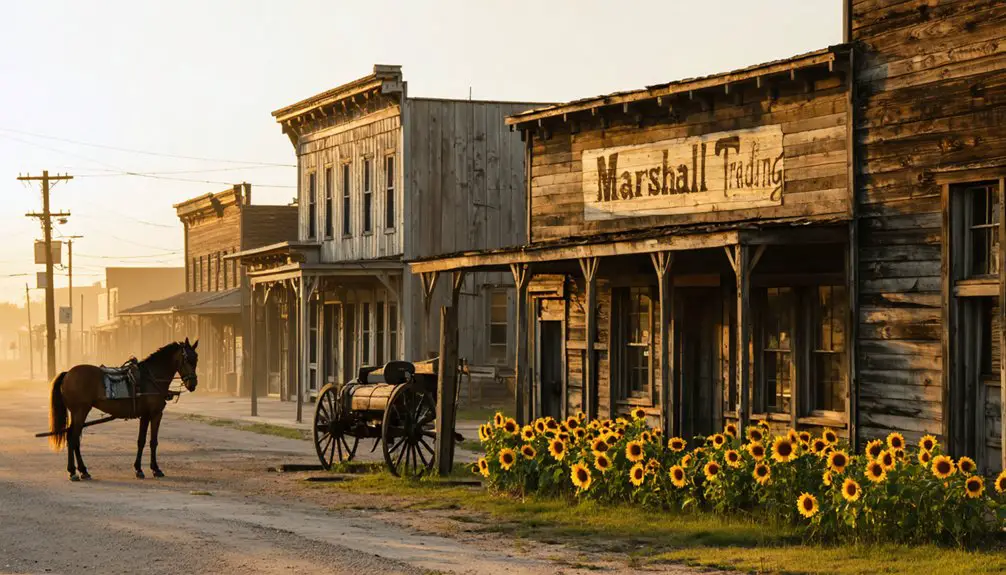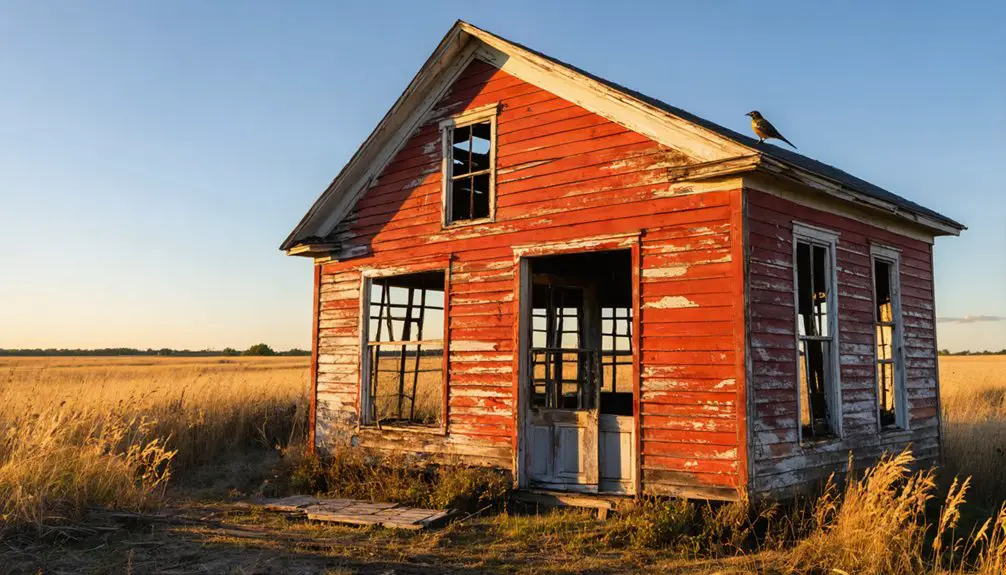You’ll find Marshall’s ghost town legacy in Kansas, where a once-thriving settlement of 10,822 residents emerged between 1870-1875. The town flourished along the Ninniskawa River, bolstered by the Central Branch Union Pacific Railroad and diverse pioneer groups from places like Clermont County, Ohio. By 1883, the entire population had relocated to Cheney, Kansas, following railroad developments. The abandoned town’s preserved structures and records reveal an untold chapter of American westward expansion.
Key Takeaways
- Marshall, Kansas became a ghost town in 1883 when its entire population relocated to Cheney following railroad development patterns.
- The town’s abandonment coincided with the Santa Fe railroad’s expansion, which redirected economic activity away from Marshall.
- Before becoming a ghost town, Marshall thrived along the Ninniskawa River with water-powered mills and trading centers.
- Marshall’s original structures, including the 1869 Presbyterian church and 1868 stone school, remain as abandoned historical landmarks.
- The 1879 tornado and subsequent railroad bypass contributed to Marshall’s decline and eventual abandonment as a settlement.
The Rise of Marshall’s Settlement (1870-1875)

While several pioneer settlements dotted Marshall County as early as 1855, the organized development of Marshall’s settlement gained momentum in the 1870s through the convergence of diverse settler groups.
You’ll find that pioneer challenges shaped the community dynamics, as settlers from Ohio, particularly Clermont County, established themselves on the high prairie. The region’s strategic location along the Big Blue, Little Blue, and Vermillion rivers attracted professionals like doctors, lawyers, and teachers alongside farmers. By 1875, the area had grown to a substantial population of 10,822.
Free-state advocates, including Captain S. B. Todd’s Massachusetts group and the Ohio Colony Company, helped establish foundational governance structures. The settlement reflected a purposeful blend of agricultural and civic development, though early residents still contended with security concerns and relied on informal “border courts” for dispute resolution. The arrival of the Central Branch Railroad in 1867 transformed the region’s economic prospects.
Railroad’s Influence on Marshall’s Fate
As the Central Branch Union Pacific Railroad plotted its westward expansion from Atchison through Marshall County in the late 19th century, you’ll find that its presence became the defining factor in the region’s destiny.
The railroad expansion initially brought prosperity, connecting local farmers to broader markets for their corn, wheat, and livestock. You’ll notice that towns with rail access flourished, aiming to become essential trading centers. Concerned citizens later formed preservation societies to protect the historic railway infrastructure.
However, the economic impact proved volatile. The Panic of 1893 triggered railroad bankruptcies and reorganizations, destabilizing local service. The St. Joseph & Western railroad’s arrival in 1870 had already established multiple shipping points throughout the county, shaping local trade patterns for decades to come.
Life Along the Ninniskawa River
The banks of the Ninniskawa River shaped Marshall’s early development long before the railroad’s arrival.
You’ll find evidence of vibrant cultural interactions between settlers and Native American tribes who established essential trading networks along strategic river crossings.
The river’s distinctive features influenced settlement patterns and economic growth:
Natural waterways shaped how settlers built their communities and businesses along the Ninniskawa’s strategic banks.
- Dramatic 40-foot rock bluffs and solid riverbeds defined the landscape
- Water-powered mills harnessed over 1,500 horsepower of natural energy
- Ferry services and trading posts connected growing communities
- Agricultural colonies flourished on thousands of riverside acres
- Stone dams embedded in bedrock demonstrated infrastructure innovation
Life centered around these waterways, where pioneer families built log cabins, blacksmith shops, and general stores. Francis J. Marshall established a crucial ferry crossing in 1849 that became a vital transportation link.
The river crossings became natural gathering points for local elections and governance, establishing the foundation for Marshall’s early civic life. These locations served as important sites for county disambiguation discussions when determining official boundaries.
The Great Migration to Cheney
During the transformative summer of 1883, Marshall’s entire population commenced a historic relocation to Cheney, Kansas, marking one of the region’s most dramatic municipal migrations.
The town’s move coincided with broader migration patterns, including significant African American migration to Kansas during the 1870s and 1880s. You’ll find that Cheney’s growth was intrinsically linked to the Santa Fe railroad’s western expansion, with the town named after railroad officer Benjamin P. Cheney. First District Court proceedings in Marshall County had begun in March 1857, establishing early governmental foundations before the town’s eventual abandonment.
While Marshall’s residents settled primarily along what became Marshall Street, Cheney’s development paralleled the broader exodus of African Americans seeking freedom from Southern oppression. The Cheney Roller Mill became one of the town’s first major industries, producing essential flour and corn meal products for the growing community.
The railroad served as a crucial economic lifeline, facilitating both the transport of agricultural goods and the movement of diverse populations seeking new opportunities in western Kansas.
Preserving Marshall’s Pioneer Legacy
Preserving Marshall’s pioneer legacy has faced significant challenges since the town’s abandonment, with natural disasters and federal projects complicating conservation efforts.
You’ll find that heritage documentation efforts have focused on maintaining historical records and physical structures despite these obstacles.
Key preservation initiatives include:
- Maintaining the 1869 Presbyterian church and 1868 stone school buildings as representations of early infrastructure
- Protecting cemetery grounds that reflect pioneer lineage and settlement patterns
- Archiving voter records and birth registries from 1857-1858 for demographic research
- Documenting local histories through diaries and accounts of settlers like Thomas Lovewell
- Preserving lodge records that demonstrate community continuity and social organization
These efforts help safeguard Marshall’s historical significance despite the disruptions caused by grasshopper plagues, floods, and the Tuttle Creek Reservoir project.
The devastating 1879 tornado that destroyed most of the town and claimed 19 lives remains a crucial part of the preservation narrative.
The town’s final decline occurred when the railroad bypassed Marshall by two miles, leading residents to establish Cheney.
Frequently Asked Questions
What Native American Tribes Originally Inhabited the Marshall Area Before Settlement?
You’d find the Fox tribe primarily controlled the area, while the Osage Nation, Kansa (Kaw) tribe, Pottawatomie, and Sioux-related peoples also inhabited what’s now Marshall County before European settlement.
Were There Any Notable Crimes or Lawlessness During Marshall’s Brief Existence?
You won’t find documented crime incidents during the town’s brief 1870s existence. Historical records show no significant law enforcement activity, with the small farming community remaining particularly peaceful until its relocation.
What Happened to the Cemetery and Burial Sites After Marshall’s Abandonment?
Of the region’s burial grounds, only Antioch Cemetery survived intact. You’ll find most sites were destroyed by farming or weathering, with cemetery preservation failing as sandstone markers eroded and burial site maintenance ceased.
Did Any Famous Pioneers or Historical Figures Pass Through Marshall?
You won’t find many documented pioneer stories of famous figures in Marshall, though early settlers like John D. Wells and A.G. Barrett left their mark on nearby historical landmarks and settlements.
What Natural Resources, Besides Water, Were Available in Marshall’s Vicinity?
You’d discover mountains of limestone, extensive sand and gravel deposits from the Big Blue River, valuable gypsum reserves, and rich agricultural land, though there’s no mention of timber resources in Marshall’s vicinity.
References
- https://www.youtube.com/watch?v=iB5rHT14eVI
- https://en.wikipedia.org/wiki/Bigelow
- https://octa-trails.org/archaeology/uniontown-and-plowboy-potawatomi-ghost-towns-enigmas-of-the-oregon-california-trail/
- https://legendsofkansas.com/irving-kansas/
- https://www.youtube.com/watch?v=Td_gmiDMfI4
- http://www.ksgenweb.org/archives/1878/marshall.html
- https://lostkansas.ccrsdigitalprojects.com/sites/lostkansas/files/private_static/2023-06/LT_MS_Irving_Allen.pdf
- https://www.kancoll.org/books/cutler/marshall/marshall-co-p10.html
- https://legendsofkansas.com/kansas-time-line/
- https://ldsgenealogy.com/books2/historyofmarshal01fost.pdf



